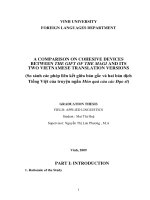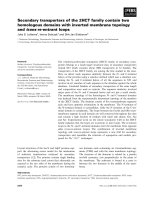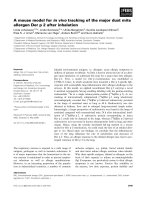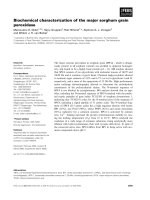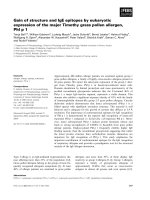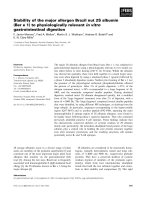Invasive myoepithelial carcinoma ex pleomorphic adenoma of the major salivary gland: Two case reports
Bạn đang xem bản rút gọn của tài liệu. Xem và tải ngay bản đầy đủ của tài liệu tại đây (2.68 MB, 6 trang )
Wakasaki et al. BMC Cancer (2016) 16:827
DOI 10.1186/s12885-016-2871-3
CASE REPORT
Open Access
Invasive myoepithelial carcinoma ex
pleomorphic adenoma of the major salivary
gland: two case reports
Takahiro Wakasaki1,3*, Marie Kubota1, Yutaka Nakashima2, Eri Tomonobe1, Takenao Mihara1 and Junichi Fukushima1
Abstract
Background: Myoepithelial carcinoma (MEC) is a rare salivary gland tumor. Its long-term prognosis remains
unknown because of the paucity of reported cases with long-term follow-up. Although some case series exist, the
clinical features of MEC vary considerably depending on the site of origin. Therefore, accumulation of these rare
cases is important.
Case presentation: Case 1: An 89-year-old man presented with a 10-year history of a mass originating from the
right parotid gland and involving the neck. The mass grew rapidly for 3 months, reaching approximately 8 cm.
There was no facial paralysis. MEC ex pleomorphic adenoma (PA) was suspected. Superficial parotid gland resection
was performed in 2013; the tumor grade was pT3N0M0, and the resection margins were free of carcinoma. Because
of several high-risk factors for metastasis (i.e., invasive carcinoma ex PA, high MIB1 index, and mutant p53 protein
positivity), radiotherapy and chemotherapy were recommended as adjuvant therapy. Although the patient refused
adjuvant therapy, he was recurrence-free at 36 months after surgery.
Case 2: A 54-year-old woman presented with a >10-year history of a right submandibular mass, which grew rapidly for
1 year, reaching approximately 6 cm. Preoperative diagnosis was PA of the right submandibular gland. Submandibular
gland resection was performed in 2013. Pathological analysis revealed invasive MEC ex PA, pT3N0M0; in addition, the
carcinoma portion had an extra capsule and had invaded the platysma muscle close to the margin. An MIB1 index of
40 % and mutant p53 protein positivity indicated a high risk for metastasis. Additional resection and right neck
dissection revealed no residual carcinoma. The patient refused adjuvant chemotherapy. One year after surgery,
metastasis to the right pulmonary hilar node and both lungs were detected. Chemotherapy prevented recurrent
growth of the lesion and extended survival. The patient was alive with cancer 30 months after the first surgery.
Conclusions: High expression of the Ki67 labeling index might reflect prognosis of these cases. Chemotherapy for
distant metastasis was effective, as expected. Further accumulation of cases and long follow-up data are needed to
elucidate the pathophysiology and prognosis of MEC ex PA.
Keywords: Case report, Myoepithelial carcinoma, Malignant myoepithelioma, Ex pleomorphic adenoma, Major salivary
gland, Ki67 labeling index
* Correspondence:
1
Department of Otorhinolaryngology, Japanese Red Cross Fukuoka Hospital,
3-1-1 Okusu, Miniami-ku, Fukuoka 815-8555, Japan
3
Department of Head and Neck Surgery, National Hospital Organization,
Kyushu Cancer Center, 3-1-1 Notame, Miniami-ku, Fukuoka 811-1395, Japan
Full list of author information is available at the end of the article
© The Author(s). 2016 Open Access This article is distributed under the terms of the Creative Commons Attribution 4.0
International License ( which permits unrestricted use, distribution, and
reproduction in any medium, provided you give appropriate credit to the original author(s) and the source, provide a link to
the Creative Commons license, and indicate if changes were made. The Creative Commons Public Domain Dedication waiver
( applies to the data made available in this article, unless otherwise stated.
Wakasaki et al. BMC Cancer (2016) 16:827
Background
Myoepithelial carcinoma (MEC) is a rare salivary gland
tumor, accounting for 0.1–0.45 % of all salivary gland
tumors [1, 2]. MEC generally arises from the parotid gland
(29–82 % of all cases) [2] and rarely from the submandibular gland, minor salivary glands, or the upper respiratory tract [2–4]. Other than the head and neck, MEC has
been reported in the lung, breast, bronchus, mediastinum,
and others sites [2, 5, 6]. Because of its rarity, the clinical
features and pathophysiology of MEC are not well characterized; most articles describing MEC are case reports.
According to a few large case series (>10 cases), the
mortality rate of MEC is 20–73 % [2, 7–9]. Regional node
involvement is reported in 0–41 % of cases [3, 7]. A
distant metastasis rate is approximately 6.8–47 %, most
commonly to the lung, brain, spine, and skin [2]. These
values may differ considerably depending on the site of
origin of MEC. Furthermore, the efficacy of radiation
therapy and/or chemotherapy for MEC remains unclear
because of the varied clinical courses. Preoperative diagnosis of salivary gland tumors is often difficult because of
the overlap in histopathological characteristics. Moreover,
even if the pathological diagnosis is established postoperatively, there is no consensus on appropriate adjunctive
treatment strategies because of the rarity of salivary gland
tumors, such as MEC [10]. Although high-risk factors for
MEC of the major salivary gland have been gradually
proposed, the accumulation of a greater number of cases
is necessary to determine effective treatment strategies.
Page 2 of 6
We present two cases of MEC ex pleomorphic adenoma (PA) of the major salivary gland. The prognosis of
these cases was reflected by an unusually high Ki67
labeling index. We also summarize the risk factors for
MEC ex PA with a mini-review of the literature.
Case presentation
Case 1: An 89-year-old man presented to us in 2013
with a 10-year history of a mass originating from the
right parotid and involving the neck. The mass grew
rapidly for 3 months before the patient was examined.
At presentation, the diameter of this rubbery hard mass
was approximately 8 cm. There was no facial paralysis.
Computed tomography (CT) showed an irregular mass
of the right parotid gland with partially defined margins
and no lymph node metastases (Fig. 1a). Magnetic
resonance imaging (MRI) was not performed because of
presence of metal implants for a left leg fracture. Fine-needle aspiration cytology (FNAC) of the parotid mass
indicated PA. We suspected that the mass was a malignant tumor, particularly a carcinoma ex PA. Therefore,
superficial parotid gland resection was performed in
March 2013. Intraoperatively, the facial nerve was found
attached to the tumor, although the tumor was resected
without sacrificing the facial nerve. Pathological analysis
of the tumor revealed MEC ex PA (pT3N0M0), MEC
component was clear cell type, and the resection margin
was free of carcinoma. The histological grade was low
according to the grading system of Savera [11]. (Fig. 1b,
Fig. 1 Enhanced CT revealed a large left neck mass with partial enhancement. Necrosis of the inner tumor was suspected. a Macroview of the tumor: PA
was completely surrounded by MEC. Red line, cancer; blue line. PA, b MRI revealed a mass with bumpy surface in the right submandibular gland with a
partially unclear border. c Macroview of the tumor: MEC existed outside of PA. Red line, cancer; blue line, PA
Wakasaki et al. BMC Cancer (2016) 16:827
Fig. 2a–d). PA was completely surrounded by carcinoma
that indicated pathological invasiveness [12]. Immunohistochemical (IHC) analysis was positive for S-100 protein, pan-cytokeratin (AE1/AE3), smooth muscle actin,
p63, and p53 (Fig. 2c, d). Moreover, the nucleus was moderately positive for mindbomb E3 ubiquitin protein ligase
1 (MIB-1) (active area, 20 %) (Fig. 2b). The patient was
considered as high risk because of the findings of invasive
MEC ex PA and mutant p53 protein positivity; thus,
radiotherapy for the locoregional area was recommended.
However, the patient refused adjuvant therapy because of
his age. At the 36-month postoperative follow-up, he was
still without recurrence.
Case 2: A 54-year-old woman presented to us in 2013
with a >10-year history of right submandibular lesion. The
growth of the mass was slightly faster 1 year before presentation. At presentation, the elastic hard mass was approximately 6 cm in diameter, and there was no facial paralysis.
MRI showed an irregular mass in the right submandibular
gland with partially defined margins (Fig. 1c). There was no
indication of lymph node metastases on ultrasonography
and MRI. Both dynamic MRI and FNAC from the submandibular mass indicated PA. However, we also suspected
carcinoma ex PA because of the rapid growth of the tumor.
Submandibular gland resection was performed in July 2013.
During resection, part of the platysma muscle with
suspected adhesion was removed, and the mass was excised
along the capsule. The marginal mandibular branch of the
facial nerve was preserved because it was not adhered to
the tumor. Pathological analysis of the tumor revealed
invasive MEC ex PA, pT3N0M0, whereas the carcinoma
portion had an extracapsular spread into and invaded the
Page 3 of 6
platysma muscle. The excision stump was close to the
carcinoma portion (Fig. 1d, Fig. 3a–d). The MEC component comprised clear cell type. The histological grade was
high [11]. IHC analysis was positive for S-100 protein, AE1/
AE3, and p53 (Fig. 3c, d). Moreover, the nucleus was
strongly positive for MIB1 (active area, 40 %) (Fig. 3b),
whereas IHC analysis was negative for p63. Because of the
close margin, right neck dissection (levels I–III) and
additional resection of the submandibular tissue, including
the platysma muscle around the tumor, was performed in
August 2013. Pathological analysis revealed no regional
metastases or residual carcinoma in the additional resected
tissue. Because of several positive risk factors (invasive MEC
ex PA, high MIB1 index, and mutant p53 protein positivity),
radiotherapy and chemotherapy were recommended as adjuvant therapy. At that time, she refused additional therapy
and was followed as an outpatient. One year after surgery,
distant metastasis to the right pulmonary hilar node and
lungs was revealed by follow-up CT and 2-deoxy-2-[fluorine-18]fluoro-D-glucose positron emission tomography integrated with CT. There were typical multiple metastases to
both lungs, with a maximum tumor diameter of 3 cm. We
diagnosed the lesions on observation of distant metastases
from the known salivary gland malignancy according to the
typical CT imaging and the clinical course of the enlarging
multiple nodules at the peripheral lung field and right hilar
node. Eight cycles of chemotherapy with cyclophosphamide
500 mg/m2, cisplatin 50 mg/m2, and adriamycin 50 mg/m2
were intermittently initiated [13]. No serious adverse events
were observed during chemotherapy. The lung metastases
were controlled; therefore, at the follow-up 30 months after
the first surgery, she was still alive with cancer.
Fig. 2 (a–d) Case 1. Histopathologic features of MEC. a H&E stain. b IHC analysis reveals Ki67 positivity in nuclei. The MIB index was approximately
20 %. c IHC analysis revealed S-100 positivity in the cytoplasm. d IHC analysis revealed p53 positivity in the nuclei
Wakasaki et al. BMC Cancer (2016) 16:827
Page 4 of 6
Fig. 3 (a–d) Case 2. Histopathologic features of MEC. a H&E stain. b IHC analysis revealed Ki67 positivity in the nuclei. The MIB index was approximately
40 %. c IHC analysis revealed S-100 positivity in the cytoplasm. d IHC analysis revealed p53 positivity in the nuclei
Discussion
We experienced two cases of MEC ex PA of the major
salivary gland. The MEC in Case 2 presented with a
clinically aggressive behavior compared to Case 1, which
was also indicated by the MIB1 index score. However,
chemotherapy for Case 2 could contribute to an
improvement in the quality of life in the future, for
example, prevention from dyspnea or pleural effusion,
and extended survival.
Precise preoperative diagnosis of MEC ex PA is almost
impossible, and risk factors for prognosis remain uncertain [2]. Symptoms of MEC are similar to those of other
salivary gland tumors, i.e., a mass with or without pain,
facial palsy, and fixation of the mass to the underlying
structures [3]. As with other high-grade malignancies,
the usefulness of FNAC is limited for preoperative
diagnosis of salivary gland carcinoma [14]. The sensitivity of FNAC for the preoperative diagnosis of carcinoma
ex PA is only 29–54 % [15, 16]. In our patients, it was
also not possible to arrive at a preoperative diagnosis,
although the preoperative clinical course of both
suggested salivary gland tumor.
Pathological analysis is performed to identify risk factors
and plan adjuvant therapies. However, specific risk factors
and the efficacy of postoperative therapy for MEC ex PA
remain unknown. Past reports and reviews have suggested
candidate markers to predict the prognosis of MEC
(Table 1). MECs originating from a minor salivary gland
reportedly have relatively better prognoses [17]. However,
whether prognosis for MEC ex benign tumor, particularly
PA, is better than for de novo MEC remains controversial.
Some reports claim that a de novo mass is highly
malignant with high relapse rates, whereas others report
the contrary [3, 8, 18]. Thus, prognosis of MEC ex PA
remains unknown [15]. The presence of spindle cells may
correlate with aggressive behavior, nodal metastasis, and
distant metastasis [3]. Most tumors that display histologic
aggressiveness behave adversely [2]. Some reports have
described the relationships between IHC findings and the
clinical course. Overexpression of Ki67, which reflects cell
proliferation, might be a useful marker of high risk of
prognosis in MEC. Nagao et al. reported that four of five
patients with high expression of nuclear Ki67 (MIB1-index
>30 %) died of the disease [1]. They also described that
the mean MIB1-index of fatal and favorable cases was
51.6 % (SD: 11.4 %) and 25.7 % (SD: 13.2 %), respectively.
We understand that the definition about high MIB1 index
of the MEC in the salivary gland remains unknown.
However, we think that a value of 30–40 % greater than
Table 1 Summary of the suggestive risk factor for poor prognosis
in MEC
High risk
Histological findings: Spindle cell type [3]
IHC for p53, p63 is positive, Ki67 labeling index is high [1, 3, 5]
Clinical stage, size, extensive invasion into the surrounding
tissue, perineural invasion [2, 12, 19]
Low risk
Site of origin: a minor salivary gland [17]
Histological findings: Clear cell component [20]
Unknown or Equivalent or controversial
MC derived from benign tumor, PA, or myoepithelioma [2, 21]
Wakasaki et al. BMC Cancer (2016) 16:827
Page 5 of 6
Table 2 Summary of the treatment modality and outcomes in MEC of salivary gland among the larger series in the literature
Article/year
Number o.
of patients
Treatment
Recurrence
Mortality
by tumor
Time of
Follow-up
Kane et al./2010 [3]
44
Radical Surgery (44) Radiation Therapy (12)
18/44
NA
1y–10y
Yu et al./2003 [7]
27
Radical Surgery (26) Radiation Therapy (12)
14/27
10/27
9 m–17y
Savera et al./2000 [11]
25
Radical Surgery (25) Radiation Therapy (6)
Chemotherapy (2)
8/17a
5/17
6 m–8y
Santos et al./2016 [21]
19
Radical Surgery (19) Radiation Therapy (9)
Chemotherapy (1)
7/19
4/19
2 m–15y
Jiang et al./2012 [5]
11
Radical Surgery (11) Radiation Therapy (9)
Chemotherapy (2)
6/11
4/11
1y–6y
Dipalma et al./1993 [8]
10
Radical Surgery (10)
8/10
2/10
1y–35y
Modification and Reference from S. Vilar-Gonzalez et al. 2015 Clin Transl Oncol
a
8 of 25 patients were lost to follow-up
the MIB1 index might support distinguishing of the higher
grade carcinoma in MEC. Therefore, we think that case 2
is of a high grade malignancy. Mutant p53 or p63 protein
positivity has been reported as a risk factor of various
cancers and presents a potential marker for a high risk of
malignancy and prognosis for MEC [1, 5]. The MIB1
index for Case 2 was 40 %, which indicated a high risk for
malignancy and might reflect early distant metastasis,
compared to Case 1.
A list of the treatment modality and outcomes in the
MEC of the salivary gland from previous articles is summarized in Table 2. In most reported cases, the initial
strategy is tumor resection [1, 2]. Because MEC is a
highly malignant, radical resection is most desirable, if
possible. Although there is currently no consensus on
strategies to preserve the facial nerve, with high-grade
cancer and cases of local recurrence, the cancerous portions of the salivary gland should be resected with facial
nerve sacrifice [3, 17]. Regarding neck dissection, there
is little information about the risk factors of regional
lymph node metastasis; therefore, elective neck dissection should be determined on a case-by-case basis.
Although the efficacy of radiation therapy for MEC ex
PA remains unknown, adjuvant radiotherapy with or
without chemotherapy is suggested for high-grade
malignancies with residual tumor/close margin, neural/
perineural invasion, soft-tissue extension, lymph node
involvement, or lymphatic/vascular invasion, as well as
after salvage surgery for recurrent tumors [12, 19].
Moreover, the efficacy and the optimal timing of chemotherapy for MEC ex PA too remain unclear. In most
cases, chemotherapy was administered concurrently with
radiotherapy as an adjuvant therapy or solely for distant
metastasis. Chemotherapy might be useful for patients
with distant metastases, as illustrated by Case 2 in this
study, in which chemotherapy for pulmonary metastasis
appeared to help control problems related to the quality
of life from occurring in the future and extend survival.
Conclusions
We reported two rare cases of MEC ex PA originating in
the major salivary gland. High expression of the Ki67
labeling index might reflect prognosis of these cases,
and chemotherapy for distant metastasis was effective,
as expected. Further accumulation of cases and long
follow-up data are needed to elucidate the pathophysiology and prognosis of MEC. We will continue to follow
these patients to obtain long-term survival data.
Abbreviations
CA: Carcinoma; CT: Computed tomography; ex PA: ex pleomorphic
adenoma; FNAC: Fine-needle aspiration cytology; IHC: Immunohistochemical;
MEC: Myoepithelial carcinoma; MRI: Magnetic resonance imaging
Acknowledgments
The authors would like to thank Enago (www.enago.jp) for the English language
review.
Funding
Grant support: This study was supported in part by funds from JSPS Grant-inAid for Scientific Research (C) 16 K11256 to Takahiro Wakasaki.
Availability of data and materials
The datasets supporting the conclusions of this article are included within
the article.
Authors’ contributions
TW drafted the manuscript. JF edited the manuscript. TW, MK, ET, TM, and JF
were in charge of patient care and performed all surgeries. YN was in charge of
the pathological diagnosis. All authors read and approved the final version of
the manuscript.
Competing interests
The authors declare that they have no competing interests.
Consent for publication
Written informed consent was obtained from both patients for the publication
of this case report and accompanying images. A copy of the consent form is
available on request from the Editor-in-Chief of this journal.
Ethics approval and consent to participate
This case report was not required to be reviewed by the Institutional Review
Board committee at Fukuoka Red Cross Hospital. This case report has been
performed in accordance with the Declaration of Helsinki.
Wakasaki et al. BMC Cancer (2016) 16:827
Page 6 of 6
Author details
1
Department of Otorhinolaryngology, Japanese Red Cross Fukuoka Hospital,
3-1-1 Okusu, Miniami-ku, Fukuoka 815-8555, Japan. 2Department of
Pathology, Japanese Red Cross Fukuoka Hospital, 3-1-1 Okusu, Miniami-ku,
Fukuoka 815-8555, Japan. 3Department of Head and Neck Surgery, National
Hospital Organization, Kyushu Cancer Center, 3-1-1 Notame, Miniami-ku,
Fukuoka 811-1395, Japan.
Received: 2 May 2016 Accepted: 21 October 2016
References
1. Nagao T, Sugano I, Ishida Y, Tajima Y, Matsuzaki O, Konno A, Kondo Y,
Nagao K. Salivary gland malignant myoepithelioma: a clinicopathologic and
immunohistochemical study of ten cases. Cancer. 1998;83(7):1292–9.
2. Vilar-Gonzalez S, Bradley K, Rico-Perez J, Vogiatzis P, Golka D, Nigam A,
Sivaramalingam M, Kazmi S. Salivary gland myoepithelial carcinoma. Clin
Trans. 2015;17(11):847–55.
3. Kane SV, Bagwan IN. Myoepithelial carcinoma of the salivary glands: a
clinicopathologic study of 51 cases in a tertiary cancer center. Arch
Otolaryngol Head Neck Surg. 2010;136(7):702–12.
4. Mejia-Hernandez IJ, Valdez AMC, De L-TD, Luna-Ortiz K. Malignant
myoepithelioma of the soft palate. Auris Nasus Larynx. 2013;40(2):231–4.
5. Jiang Y-H, Cheng B, Ge M-H, Zhang G. The prognostic significance of p63 and
Ki-67 expression in myoepithelial carcinoma. Head Neck Oncol. 2012;4(1):9.
6. Briasoulis A, Salem N, Siddiqui F, Rashed A, Othman M. Myoepithelial
carcinoma in the mediastinum involving the left atrium. Cardiovas. 2016;
25(2):158–60.
7. Yu G, Ma D, Sun K, Li T, Zhang Y. Myoepithelial carcinoma of the salivary
glands: behavior and management. Chin Med J. 2003;116(2):163–5.
8. Di Palma S, Guzzo M. Malignant myoepithelioma of salivary glands:
clinicopathological features of ten cases. Vichows Archiv A Pathol Anat.
1993;423(5):389–96.
9. ZhengZheng L, Lv X, Shi Y, Zhang Y, Yu G, Zhang J. (125)I interstitial
brachytherapy for the treatment of myoepithelial carcinoma of the oral and
maxillofacialregion. 2016;15(2):240–5.
10. Andry G, Hamoir M, Locati LD, Licitra L, Langendijk JA. Management of
salivary gland tumors. Expert Rev Anticancer Ther. 2012;12(9):1161–8.
11. Savera AT, Sloman A, Huvos AG, Klimstra DS. Myoepithelial carcinoma of the
salivary glands: a clinicopathologic study of 25 patients. Am J Surg Pathol.
2000;24(6):761–74.
12. Antony J, Gopalan V, Smith RA, Lam AK. Carcinoma ex pleomorphic
adenoma: a comprehensive review of clinical, pathological and molecular
data. Head Neck Pathol. 2012;6(1):1–9.
13. Lagha A, Chraiet N, Ayadi M, Krimi S, Allani B, Rifi H, Raies H, Mezlini A.
Systemic therapy in the management of metastatic or advanced salivary
gland cancers. Head Neck Oncol. 2012;4:19.
14. Chhieng DC, Paulino AF. Cytology of myoepithelial carcinoma of the
salivary gland. Cancer. 2002;96(1):32–6.
15. Klijanienko J, El-Naggar AK, Vielh P. Fine-needle sampling findings in 26
carcinoma ex pleomorphic adenomas: diagnostic pitfalls and clinical
considerations. Diagn Cytopathol. 1999;21(3):163–6.
16. Nouraei SA, Hope KL, Kelly CG, McLean NR, Soames JV. Carcinoma ex
benign pleomorphic adenoma of the parotid gland. Plast Reconstr Surg.
2005;116(5):1206–13.
17. Yang S, Zeng M, Zhang J, Chen X. Clear cell myoepithelial carcinoma of minor
salivary gland: a case report. Int J Oral Maxillofac Surg. 2010;39(3):297–300.
18. Cassidy M, Connolly CE. Clear cell carcinoma arising in a pleomorphic
adenoma of the submandibular gland. J Laryngol Otol. 1994;108(6):529–32.
19. Pfister DG, Spencer S, Brizel DM, Burtness B, Busse PM, Caudell JJ, Cmelak
AJ, Colevas AD, Dunphy F, Eisele DW, et al. Head and neck cancers, version
1.2015. J Natl Compr Canc Netw. 2015;13(7):847–55. quiz 856.
20. Michal M, Skalova A, Simpson RH, Rychterova V, Leivo I. Clear cell malignant
myoepithelioma of the salivary glands. Histopathology. 1996;28(4):309–15.
21. Passador-Santos F, Gronroos M, Irish J, Gilbert R, Gullane P, Perez-Ordonez B,
Makitie A, Leivo I. Clinicopathological characteristics and cell cycle proteins
as potential prognostic factors in myoepithelial carcinoma of salivary glands.
Virchows Arch. 2016;468(3):305–12.
Submit your next manuscript to BioMed Central
and we will help you at every step:
• We accept pre-submission inquiries
• Our selector tool helps you to find the most relevant journal
• We provide round the clock customer support
• Convenient online submission
• Thorough peer review
• Inclusion in PubMed and all major indexing services
• Maximum visibility for your research
Submit your manuscript at
www.biomedcentral.com/submit

